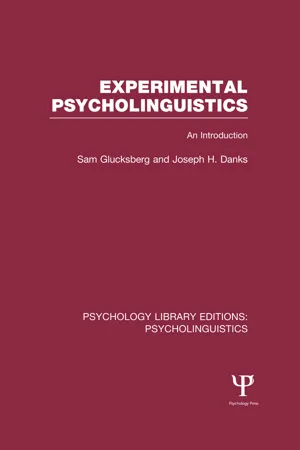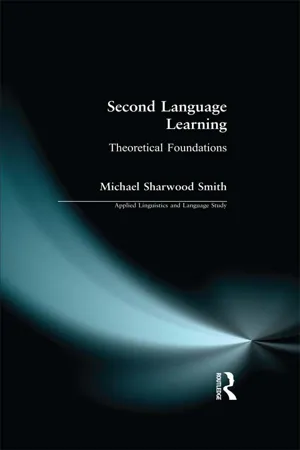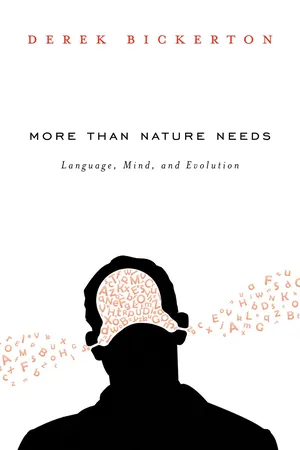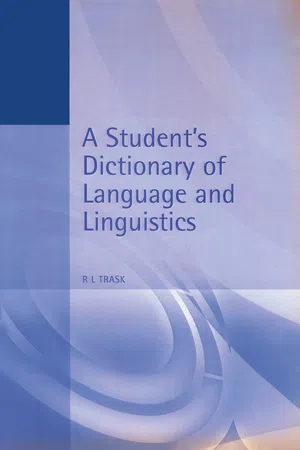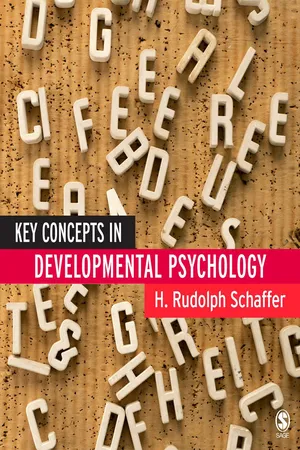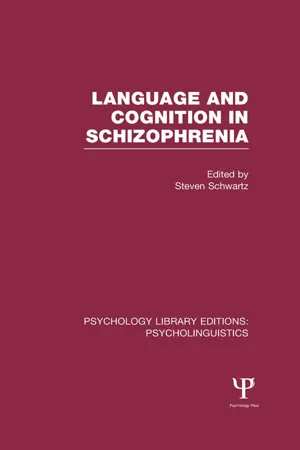Languages & Linguistics
Language Acquisition Device (LAD)
The Language Acquisition Device (LAD) is a theoretical concept proposed by Noam Chomsky to explain how children are able to rapidly and effectively learn language. According to Chomsky, the LAD is an innate cognitive structure that enables children to acquire language skills through exposure to linguistic input. It is believed to be a universal feature of the human mind, allowing for the acquisition of any language.
Written by Perlego with AI-assistance
Related key terms
9 Key excerpts on "Language Acquisition Device (LAD)"
- eBook - ePub
Experimental Psycholinguistics (PLE: Psycholinguistics)
An Introduction
- Sam Glucksberg, Joseph H. Danks(Authors)
- 2013(Publication Date)
- Psychology Press(Publisher)
First, the rules children use in the early stages are not the same rules that adults use. Second, it is doubtful that rules could be taught explicitly with much success. What would it mean to a two-year-old child to be told that we form the past tense of regular verbs by adding the suffix -ed ? Rules like this must somehow be inferred or discovered by everyone who learns to speak English as a first language. For lack of an adequate understanding of how language might be learned, a mechanism for language acquisition has been postulated. This is the LANGUAGE ACQUISITION DEVICE (or LAD). The language acquisition device may consist of a unique capacity or ability that is specialized for language acquisition (Chomsky, 1968; McNeill, 1966a). Alternatively, it may consist of a concatenation of general cognitive abilities, including sensory, perceptual, conceptual, and social mechanisms (Slobin, 1971b). Whichever it may be, the language acquisition device is that subsystem of our cognitive apparatus which develops a series of grammars as the child matures. These grammars successively tend to approximate adult grammar until the final target is reached—adult language. The role of the language acquisition device in language acquisition is schematically represented in Figure 5.1, along with the potential relations among (a) the hypothetical language acquisition device; (b) the grammar; (c) external inputs (experience); and (d) various internal states. Figure 5.1 The components involved in language acquisition. Input 1 is the perception of the physical and social world, and input 2 represents the speech of people in that world. Input 3 represents the child’s developing conceptual system. The language acquisition device itself may be regarded as an integral part of that conceptual-cognitive system, or as a separate mechanism which can draw information from “cognition” and transmit information back - eBook - ePub
Second Language Learning
Theoretical Foundations
- Michael Sharwood Smith, Christopher N. Candlin(Authors)
- 2014(Publication Date)
- Routledge(Publisher)
One important idea to keep in mind is the possibility that, although there may be evidence in all kinds of different spheres of activity that there are general learning principles, we can at least expect in some subsystems that there will be very specific learning principles that are irrelevant to other areas. Acquiring knowledge of the world of, say, sounds or vision may need explanations quite separate from learning how to pass a geography test. There may be different requirements to guarantee successful learning. For instance, learners may need correction of their errors in one domain of the L2 while, in another, their learning may proceed simply by exposure to the language. If this is so, then, clearly, special learning theories are needed to account for these different areas. One set of learning principles may not be enough.Another example of thinking of knowledge and skill as being composed of different subsystems is when considering the possibility of native-like L2 ability. It may be possible for many people to achieve native levels in some subsystems but not in others. So the question of whether one can become a native speaker, and how likely that may be, can be addressed separately for each of those modules, e.g. pragmatic ability, stress and intonation, lexicon, etc. This idea of modularity will be considered later, starting with the discussion on experimentation in Chapter 4 .1.2.12 LAD
LAD stands for Language Acquisition Device and is a term that was widely used in the 1970s (see Chomsky 1965). It is a cover term for a battery of mechanisms in the mind that are supposed to be responsible for creating a highly complex grammar from the language experience that a learner – notably the very young, immature (preschool) L1 learner – undergoes. Since these mechanisms are not, according to the theoretical position adopted by the users of this term, like those which drive the learning of other types of knowledge and skill, the theoretical implication is a modular one (see 1.2.11 - eBook - ePub
- Derek Bickerton(Author)
- 2014(Publication Date)
- Harvard University Press(Publisher)
approaches the task equipped with UG ” (Chomsky 1981: 8, emphasis added). “Growth” can hardly be described as “a task”—certainly not one requiring specialized equipment.The LAD contained, among other things, a set of parameters, the values of which the child had to set, ideally by simply choosing between two preordained settings. Hence “an explanatory theory [of language acquisition] ought to specify how the learner sets the parameters … on the basis of relevant input data” (Dresher 1999: 27). This was normally conceived of as a single, serial process; the child would zero in, as it were, on the correct grammar by a progressive elimination of possible alternatives. However, a different view is equally compatible: if all grammars are potentially available to the child (as they should be if the grammars of six-thousand-odd languages are to be equally accessible and as has been implicitly assumed throughout the history of LAD), two or more grammars could be entertained simultaneously. Each would compete, acquiring points wherever it coincided with primary data, until one or the other won out, and children finally decided they were acquiring English rather than Chinese, or vice versa (Yang 2002).The seemingly commonsense notion that a language is something “out there” and constitutes some kind of “learning task” for the child is expressed even more forcefully by those who reject the notion of any form of task-dedicated innate assistance. At one end of the empiricist spectrum are those who hold some sort of “general nativist” position—there may be innate processes, but these, unlike the LAD, are not specifically dedicated to language—and who believe that acquisition remains “a process of hypothesis formation and testing” (O’Grady 1987: 173). At the other end are those who may accept that children have “underlying linguistic representations” but claim that these consist of “concrete item-based schemas” rather than “more abstract linguistic ‘rules’ ” (Tomasello 2001: 67) and thus have to be learned in the same way that any other kind of skill or knowledge has to be learned: by induction from primary data, helped by generalization and analogical reasoning. - Larry Trask(Author)
- 2014(Publication Date)
- Routledge(Publisher)
In practice, it is these individual languages which are most easily examined, and it is important to realize that only natural languages (mother tongues) strictly count for this purpose, though linguists are none the less sometimes interested in artificial languages, pidgins and even animal communication. An individual natural language may itself be viewed either as a set of rules and principles in the minds of speakers (Chomsky’s I-language) or as a set of possible sentences (his E-language). A formal language, which is always viewed as a set of sentences, is of course not a natural language, but linguists often find it useful to construct formal languages in order to compare their properties with the observed properties of natural languages; a formal language which provides a good match may tell us important things about the structures of human languages generally. language acquisition See acquisition. Language Acquisition Device (LAD) A hypothetical mental system, supposedly present in our brains at birth, which enables us to learn a first language in childhood. The LAD supposedly consists of three parts: a set of linguistic universals, a device for constructing hypotheses about possible rules of grammar, and a procedure for evaluating these hypotheses. Proposed by Chomsky, the LAD idea has now given way in his work to the parameter-setting model. language areas The well-defined regions of the brain which play a crucial role in language production and comprehension, notably Broca’s area and Wernicke’s area. language attrition The gradual loss of a language through lack of use – for example, the loss of a mother tongue by an immigrant to a country where a different language is spoken. language awareness An educational policy aimed at stimulating curiosity about language and at integrating different approaches to language within the educational system. language change Change in a language over time- eBook - ePub
- H Rudolph Schaffer(Author)
- 2006(Publication Date)
- SAGE Publications Ltd(Publisher)
modularity view of the mind. In a subsequent revision to his theory, however, he decided that only part of the UG is innate and that there are certain aspects that are dependent on experience.UG thus designates a type of grammar that is of such abstraction that it is able to characterize all languages, actual and potential. Languages do share quite a number of structural characteristics; for example, they all make distinctions between past, present and future; they all require both a subject and a predicate to make up a complete sentence; and they all divide words into grammatical categories such as nouns and verbs. If children already have some innate knowledge about such aspects the acquisition task is very much easier, in that they are provided with an implicit set of rules to guide both the comprehension and production of speech.Whereas UG can be thought of as the storehouse of grammatical knowledge, the LANGUAGE ACQUISITION DEVISE (LAD) is the agent whereby that knowledge is used. Chomsky did not specify the exact nature of this concept; however, we may think of it as –the means whereby children set about constructing the grammar of their native language from the speech they hear.Thus the stream of speech to which children are exposed is filtered through the LAD, which extracts whatever regularities occur in it (for example, add ed to a verb to indicate the past tense), and so provides children with the guidelines required for talking in their native tongue. It is an essential part of the language acquisition process that children, without being aware of it, are continuously engaged in generating hypotheses about acceptable ways of expressing themselves. Whatever regularities may occur in others’ speech are then used to construct rules – a procedure, however, that is not always foolproof, as seen in children’s use of words like goed or even wented - eBook - ePub
- Steven Schwartz(Author)
- 2013(Publication Date)
- Psychology Press(Publisher)
How would you feel about a breath of fresh air? is not interpreted as inquiring into one's naive theory of respiratory physiology but as an invitation to go for a walk.II.
Before I begin, we require a necrology in order to set the background. It is for LAD, Chomsky's (1962) Language Acquisition Device, a veritable child prodigy that, for its 10 years of sway, helped produce a new way of seeing what is involved in acquiring language — and thereby dug its own grave. LAD, let us recall, was what linguists refer to as a discovery procedure, that is to say, a means of discovering the rules by which acceptable sentences in a language are put together. Its input was a sample of the language, however encountered; its output was the set of syntactical rules that would generate all the well-formed sentences possible in the language and none that were illformed. The base of this recognition or discovery program was presumed to be the language-learner's innate grasp of the universals of language. The local language being learned, according to this view, was merely a realization in local form of the syntactic universals of language. The innate grasp of these linguistic universals of language was assumed to be independent of any knowledge of the nonlinguistic world. Nor, indeed, did the recognition program require anything more than that the learner (or discoverer) of the language be a bystander: the spoken corpus of speech flowed round and into him, and the rules came out the other end. It did not require, for example, that he already know what the language referred to — that he have concepts about the real world being referred to — nor that the learner had to enter into particular kinds of dialogue with the speakers of the language. As an enthusiastic David McNeill (1970) put it, “The facts of language acquisition could not be as they are unless the concept of a sentence is available to children at the start of their learning [p. 2].” - eBook - ePub
Desirable Literacies
Approaches to Language and Literacy in the Early Years
- Jackie Marsh, Elaine Hallet, Jackie Marsh, Elaine Hallet(Authors)
- 2008(Publication Date)
- SAGE Publications Ltd(Publisher)
This chapter focuses on the important role speaking and listening activities have in the life of the young child. It begins with an overview of the child’s early language acquisition and the different perspectives offered by those researching language, and goes on to discuss the role of the adult in developing a child’s spoken language. The complexity of the acquisition process can only be lightly sketched here, the emphasis being on the importance of interaction in learning and learning to talk. This is followed by suggestions for classroom- or home-based activities.Language acquisition – differing perspectives
Until the late 1950s the prevailing views on language acquisition were largely influenced by behaviourism until the work of Noam Chomsky marked a turning point in theories about the nature of language and the nature of language acquisition. The behaviourists’ claim that language is learned through the acquisition of linguistic habits and that imitation of adults’ speech plays an important role in learning is strongly countered by Chomsky’s assertion that language is ‘creative’, that is, human beings produce novel utterances when they speak, rather than imitations of what they have heard before:The normal use of language is innovative in the sense that much of what we say in the course of normal language use is entirely new, not a repetition of anything that we have heard before, and not even similar in pattern – in any useful sense of the terms ‘similar’ and ‘pattern’ – to sentences or discourse that we have heard in the past. (Chomsky, 1972: 12)To account for this ability to produce and understand novel utterances Chomsky claims that human beings possess an innate capacity to acquire language through the Language Acquisition Device (LAD), a mental mechanism specifically concerned with language. According to Chomsky, the adult utterances a child is exposed to are often too ill-formed and incomplete to serve as a suitable model to imitate. A child learning his or her first language will abstract rules from this rather shapeless language he or she encounters and incorporate these into his or her production/understanding of language, and will do so in a relatively short space of time.It appears that we recognise a new utterance as a sentence not because it matches some familiar pattern in any simple way, but because it is generated by the grammar that each individual has somehow and in some form internalised. Chomsky asserts that natural languages are governed by complex rules that are not apparent in ‘surface structure’, the actual utterances of a language. If a child acquiring a language had to rely solely on the snatches of language heard in his or her environment he or she would not be able to abstract, and so acquire, the rules. Evidence that children do not acquire language through imitation of adults can be seen from the ‘overgeneralisations’ evident in their speech; for example, ‘It got broked’, ‘She putted it on the carpet’. In one experiment McNeill (1966: 61) effectively demonstrated that if a child is not ready he or she will not be able to imitate an adult’s utterance: - eBook - ePub
- Marian R Whitehead(Author)
- 2010(Publication Date)
- SAGE Publications Ltd(Publisher)
After Chomsky’s (1957) attacks on behaviourism, researchers really listened to young children and began to note their innovative and unusual production of words and utterances, as well as their amazing sensitivity to rules, regularities and patterns in language. For example, children’s grammatical mistakes are highly systematic and rather admirable: in English they overgeneralize the rules for making plurals and past tenses once they have deduced the add an ‘-s’ or add ‘-ed’ rules respectively. Around age 2–5, children talk of ‘mouses’ and tell us that they ‘rided’ a bike. Clearly they are demonstrating some degree of sensitivity to regular patterns and a possibly innate ability to make analogies with the regular forms, such as ‘houses’ and ‘walked’. One thing is certain, they do not simply imitate adult speech and they are not taught explicitly that a grammar is a system of rules.The nativist view is that children are pre-programmed to learn a language and are highly sensitive to the linguistic features of their environment. Chomsky emphasizes both the process of maturation in children’s linguistic development and the essentially creative nature of all human language use. We are all continually involved in re-creating and generating new and appropriate utterances. But Chomsky’s central concern is with the human mind: he sees linguistics as the study of mind and of the mental structures that make language possible. His suggestion that there must be some internal Language Acquisition Device (LAD) that enables the young infant to process all the language it hears and generate its own meaningful utterances, led to considerable research into grammatical systems in the 1960s and 1970s. But the approach has been criticized for its tendency to look at language and the mind in a vacuum, divorced from significant human relationships and social settings, and from all the other kinds of learning with which babies are actively involved.Cognitive approaches
Cognitive psychologists in the 1970s criticized the Chomskyan preoccupation with the structures of language and its comparative neglect of the personal intentions and uses to which infants put their developing linguistic knowledge, along with all their knowledge of people and the environment. Language development was seen from this perspective to be part of general cognitive development. This view can be linked with Piaget’s descriptions of the important mental structures, or schemas, created by the infant’s interactions and explorations in the environment in the first 18 or so months of life and with modern studies of the developing infant brain. It can be claimed that early language acquisition must wait for certain synaptic links and sensorimotor strategies to develop. - eBook - ePub
Introducing Second Language Acquisition
Perspectives and Practices
- Kirsten M. Hummel(Author)
- 2013(Publication Date)
- Wiley-Blackwell(Publisher)
In this perspective, “language development is no longer seen as a process of acquiring abstract rules, but as the emergence of language abilities in real time …” (Evans, 2009, p. 128). A language-specific learning device is not considered to be innately specified, as proposed by the UG approach. Instead, inspired by the structure of the nervous system, proponents of this view suggest that language emerges out of a complex network of interconnections between neurons (e.g., Elman et al., 1996). emergentism Theoretical view proposing that phenomena of language are best explained by reference to more basic non-linguistic factors and their interaction (e.g., physiology, perception, processing, input properties, etc.). One predominant emergentist-inspired model is connectionism, which proposes that language is learned through exposure to language in the environment, the input. This exposure allows the construction of associations among units, i.e., sound sequences, words, sentence patterns, etc. The L1 develops therefore through ongoing exposure to language in the environment with increasing exposure to certain units leading to greater associative strengths. When the associations are strong enough, the units and patterns become permanently acquired
Index pages curate the most relevant extracts from our library of academic textbooks. They’ve been created using an in-house natural language model (NLM), each adding context and meaning to key research topics.
